TAGGED AS: marvel cinematic universe, movies, TV
With the release of Black Panther: Wakanda Forever, Phase 4 of the Marvel Cinematic Universe is complete. Of course, as the actual meaning of the MCU phases is an ever-shifting concept – fluid enough, in fact, that Phases 2 and 3 were revised after the fact – the true nature of Marvel Studios’ output since 2021, in terms of what it all might be leading toward and what it was all about, is up for some debate. Those questions only became more pertinent as Marvel president Kevin Feige took to the Comic-Con International: San Diego stage in July 2022 to declare Phases 4, 5, and 6 will collectively form “The Multiverse Saga.”
So, with Wakanda Forever completing the landscape of Phase 4, let’s take a look back at two years of movies (and some TV shows) for a clearer picture of what’s been going on and, perhaps, to discover why it felt the way it did for many fans. Also, we may venture into some speculation about the next two phases and, perhaps, beyond into Phase 7.

(Photo by ©Marvel Studios)
Some critics of Phase 4’s direction noted that it lacked one. Indeed, this is the case if one went in expecting the same momentum as Phase 3 and its literal endgame. And, to be fair, WandaVision and Loki gave the impression of something on the horizon, which never materialized in the films and series that followed them in the subsequent 18 months. The first feature film of the phase, Black Widow, offered the sense that perhaps things would not move into the Multiverse conflict with any sort of haste. Indeed, had the movie come out on its original May 2020 release date, its only key Phase 4 moment would have been the reveal of Contessa Valentina Allegra de Fontaine (Julia Louis-Dreyfus) and Yelena Belova’s (Florence Pugh) anger at Clint Barton (Jeremy Renner) during the stinger. Otherwise, as the introductory film of Phase 4, it appears to look backward.
One could even argue it is more properly a Phase 3 film, while the final movie of that phase, Spider-Man: Far From Home, ultimately serves as a better introduction to Phase 4, with its jokes about the Mutliverse and a villain who uses illusions to achieve his goals.
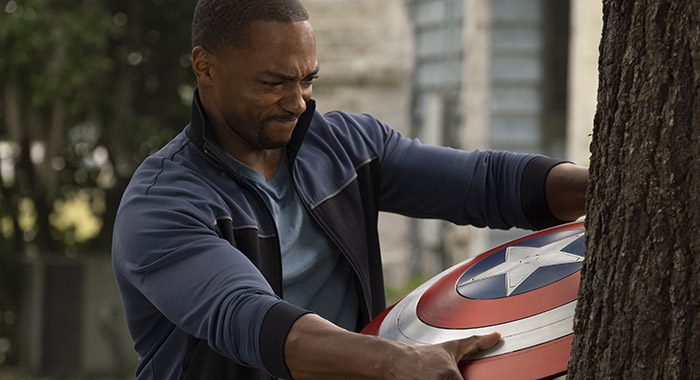
(Photo by Chuck Zlotnick, ©Marvel Studios)
But that’s assuming Phase 3-style forward momentum is even required at this stage. In terms of an ongoing narrative, Marvel had a lot to accomplish in the last two years. Beyond properly setting up its Multiverse, it still needed to deal with the fallout of Avengers: Endgame and its five-year jump. In terms of the films, this is probably expressed most acutely in Thor: Love & Thunder, as it revolves around Thor’s (Chris Hemsworth) malaise following the events of Endgame. But see also The Falcon and the Winter Solider, as it most directly relates to the political situation on Earth in the immediate aftermath of Thanos’s (Josh Brolin) defeat, and even She-Hulk: Attorney at Law for a key update on the Sokovia Accords that motivated so much of Phase 3.
And, as we’ll discuss below, a major focus was introducing the second generation of heroes. Like Phase 1, that meant spending more time with the new people and more oblique teases to how they will ultimately interact. In fact, that sense of aimlessness may come from the fact that no lower-stakes Avengers film is being developed to introduce these new characters as a team. Would we have benefited from a movie after Wakanda Forever detailing why Doctor Strange (Benedict Cumberbatch) had to assemble Shang-Chi (Simu Liu), Black Knight (Kit Harington), Spider-Man (Tom Holland), She-Hulk (Tatiana Maslany), Daredevil (Charlie Cox), Moon Knight (Oscar Isaac), and Kate Bishop (Hailee Steinfeld) as his own ersatz Avengers? Possibly. But, like Phases 1-3 before it, it could have at least offered the sense that things were building to something, if not a big fight with a Thanos-level opponent.
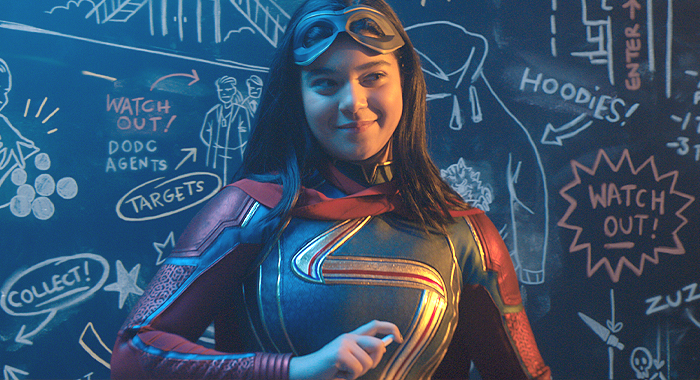
(Photo by ©Marvel Studios)
As mentioned above, Phase 4 was a reset in as much as it took great pains to introduce a lot of new people. In no particular order, the last two years saw the debut of characters like Shang-Chi, Agatha Harkness (Kathryn Hahn), Kate Bishop, Kamala Khan (Iman Vellani), America Chavez (Xochitl Gómez), and the Eternals.
Beyond the characters, though, the films and televisions series – the latter, in particular, was a shift from the previous phases – a number of situations and ideas also needed to be introduced. Chief among them was the Multiverse.
Despite the exhaustive explanation offered in Loki, including the important establishment of variants, only Spider-Man: No Way Home and Doctor Strange in the Multiverse of Madness played with the concept of other realities where the heroes are slightly different, their worst selves, or look like Tobey Maguire. But ultimately, only Loki feels like an essential part of the saga, as the title character’s variant, Sylvie (Sophia Di Martino), set into motion the cause of the coming Multiversal crisis and the arrival of Kang the Conqueror (Jonathan Majors) when Phase 5 begins. The two films, meanwhile, used the concepts to either fuel their plot (No Way Home) or to expand their setting (Multiverse of Madness). Granted, the latter’s mid-credits stinger scene suggests a third Doctor Strange outing will be far more keyed into the Multiverse Saga than its predecessor.
Then again, is it enough for these films to feature the concept at all for them to feel more essential to the saga than, say, Wakanda Forever?
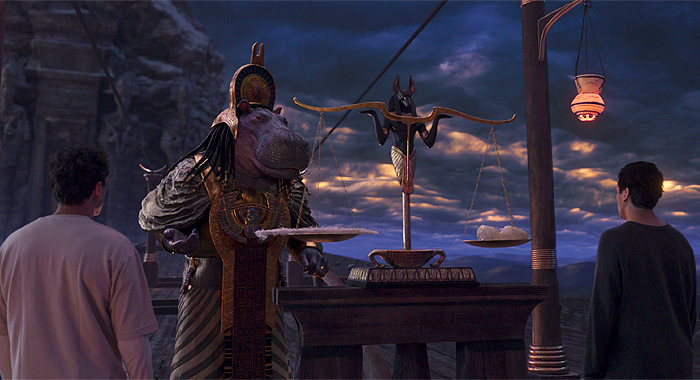
(Photo by ©Marvel Studios)
Beyond explaining the Multiverse, though, other ideas were also seeded to either bear fruit in Phase 5 and 6 or, perhaps, add nutrients to the soil of the saga after the current phase. One example is the expansion of realms beyond the nine of the Thor films and the Multiverse itself. Thor: Love & Thunder, for example, established the existence of Valhalla, a realm of dead souls not entirely dissimilar from the ancestral plane of Black Panther and Wakanda Forever, which, in turn, resembles Moon Knight’s Duat and Field of Reeds. The existence of each and Multiverse of Madness’s references to Hell suggest there are many different afterlifes, and a soul’s belief in them determines where they go upon death.
Will it matter in The Mutliverse Saga? Probably not, but establishing Valhalla, the Ancestral Plane, Hell, the Duat, and the Noor Dimension (as referenced in Ms. Marvel) could be setting up a subsequent multi-year saga, potentially about a war between the heavens and the powers they unleash in the mortal plane. See also Blade’s (Mahershala Ali) off-screen cameo at the end of Eternals and the Disney+ Werewolf by Night special as evidence of something more overtly supernatural than the science-based magic of Asgard or even the Mystic Arts of Sorcerer Supreme Wong (Benedict Wong). Vampires, werewolves, and even the Egyptian pantheon speak to a horror film tradition Marvel Studios clearly wants to tap into, but they don’t seem to fit into the Multiverse direction of the current phases. Establishing those ideas now could have a satisfactory payoff, even if it leaves Phase 4 a little disjointed.
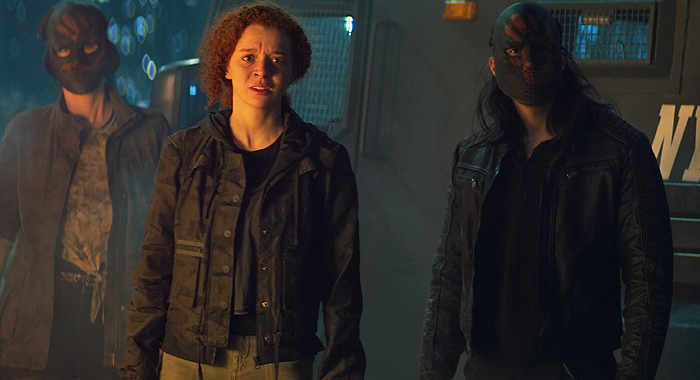
(Photo by ©Marvel Studios)
Meanwhile, more down-to-Earth concepts introduced in Phase 4 include the issue of Global Repatriation for those who disappeared in the Blip and those who utterly altered their lives because they were not snapped away. As glimpsed in The Falcon and the Winter Soldier, it’s a very big deal, even if subsequent film and television releases seemingly ignored it entirely. Of course, the plots of the film releases made acknowledging those things tough, with Thor (Chris Hemsworth) out in the galaxy, Doctor Strange (Benedict Cumberbatch) lost in his own concerns and the Multiverse, and Wakanda itself grieving the loss of its king. Nevertheless, we expect the issue to come up again in Phase 5’s Captain America: New World Order as either the Leader (Tim Blake Nelson) or some other group uses the instability caused by the Global Repatriation Council to their advantage.
But it is absolutely one of those lingering things you’d expect to get some larger references to in Shang-Chi and the Legend of the Ten Rings, No Way Home, or Eternals. At the same time, it is a lot to expect each production to offer even a scene continuing those threads. While Marvel Comics is well-versed in serving company-wide crossovers and storylines, doing the same in film (and television to an extent) may be more of a commitment than filmmakers are prepared to make.
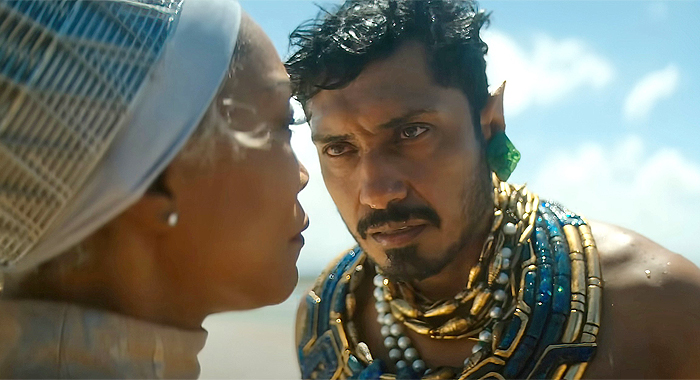
(Photo by ©Marvel Sudios)
Also, only so much attention could be paid to the GRC before Wakanda Forever delivered what may be the most important introduction of the phase: Namor (Tenoch Huerta) and the nation of Talokan.
They are important geopolitical players in the Marvel Comics Universe, and their inclusion, albeit with altered origins, is key to the future of the MCU’s Earth. Like Wakanda, it is a sovereign nation mostly free from the stains of colonialism and, seemingly, the only other source of vibranium on the planet. And though Shuri (Letitia Wright), Okoye (Danai Gurira), and Everett K. Ross (Martin Freeman) kept Talokan’s existence a secret from other nations, it is only a matter of time before Namor feels the call to destroy the surface world again. Additionally, it is inevitable that the US government will learn of Talokan and attempt the very thing its ruler wants to avoid.
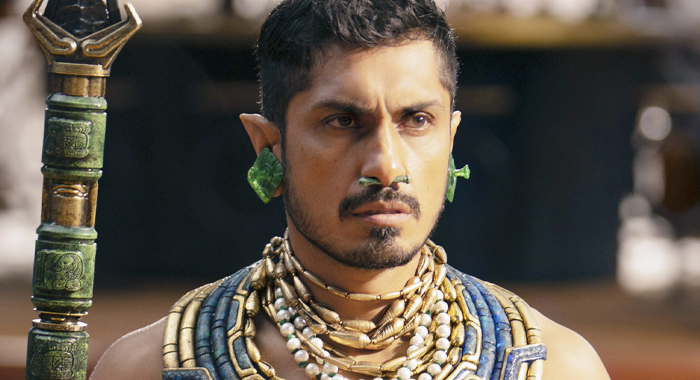
(Photo by Eli Ade/©Marvel Studios)
As for Namor himself, he is one of the most charismatic antagonists we’ve seen so far. His position is not without merit, and his primary motivation, protecting his people, is a just one. But the downside of a man who adopts a portmanteau of “sin amor” as his name is how easily he can be swayed by his heartlessness. His comic book counterpart often straddles a fine line between anti-hero and villain for very similar reasons; his passions often lack empathy for almost everyone outside of his domain. Of course, Fantastic Four readers know there is one surface-dweller Namor has a particular passion for, and we expect this connection may matter in the fullness of time.
Also, Namor self-identifying as a Mutant is more monumental than the moment in Wakanda Forever itself seems. Although he seems to refer to his ability to breathe underwater and on the surface as a unique quirk of his birth, the word still carries a special connotation in an MCU awaiting the arrival of Deadpool (Ryan Reynolds) and Wolverine (Hugh Jackman) in Deadpool 3. But like the reference to mutation in Ms. Marvel, the unusual abilities Namor and Kamala Khan possess are tied to something very specific: an introduction Marvel fans have been waiting for since Disney finalized its purchase of the 20th Century Fox assets and returned the X-Men movie rights to Marvel Studios. But like our hypothetical war of the heavens, Marvel’s Merry Mutants will likely have to wait for a time after The Multiverse Saga.
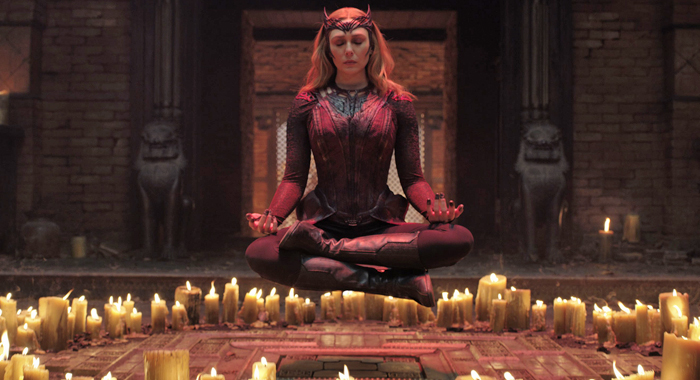
(Photo by Marvel Entertainment)
Opening with Wanda Maximoff’s (Elizabeth Olsen) turn to darkness in WandaVision and Natasha Romanoff (Scarlett Johansson) confronting her own ill deeds in Black Widow, Phase 4 was, in many ways, an opportunity for the bad guys to have their day. Of course, “bad guy” is a relative term in the cases of Namor, Karli Morgenthau (Erin Kellyman), and He Who Remains (Majors), but even Gorr the God Butcher (Christian Bale) and Xu Wenwu (Tony Leung) espoused some worthy ideas. Sympathetic villains do not necessarily mean their cause is ultimately just, though, and out of the group listed above, only Namor remains alive and in control of the resources he had before coming into conflict with a Marvel hero. Granted, it is still unclear just what really became of the Scarlet Witch after she seemingly died in Multiverse of Madness, but the point still stands: the villains (or antagonists) had a greater suggestion of complexity throughout the phase, which, in turn, suggests the possibility of antagonists with more longevity than a single film or series.
For those looking to find some sort of resonance between all the surviving antagonists in Phase 4 – which includes Wu Xialing (Meng’er Zhang), Agatha Harkness, the Power Broker (Emily VanCamp), Baron Zemo (Daniel Brühl), Namor, Eleanor Bishop (Vera Farmiga), Wilson Fisk (Vincent D’Onofrio), and arguably Khonshu (F. Murray Abraham) and Wanda – consider the possibility that Kang will offer them some piece of his dynasty in exchange for collaboration. In fact, it’s possible he’ll reach out to other realities and offer the same deal to variants of villains we saw die.
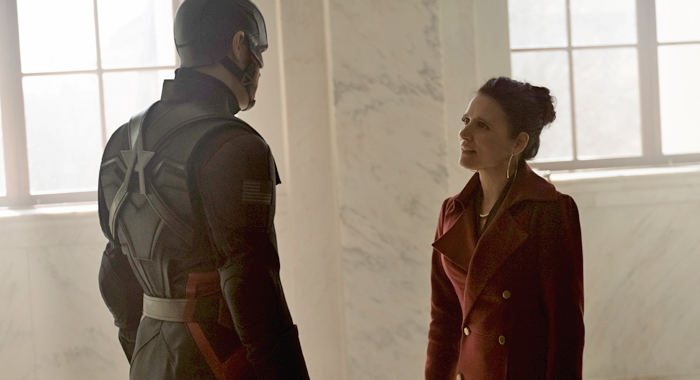
(Photo by ©Marvel Studios)
Of course, there are a handful of events that serve as little more than narrative hooks for a subsequent film, series, phase, or saga. The following are just some of the questions left dangling as Phase 4 came to a close.
Will Black Knight make some sort of public appearance before Blade or Eternals 2?
With Blade delayed, it is possible the character may make some sort of substantial in-costume appearance elsewhere – particularly if he is meant to serve some role in The Multiverse Saga.
Will Val ultimately run the Thunderbolts since she’s already assembling the group?
The character (and the actor) was conspicuously absent from the Thunderbolts cast revealed at the D23 Expo in 2022. And with word that Harrison Ford will replace the late William Hurt as General “Thunderbolt” Ross in New World Order, it is possible he will assume command of her hand-picked assortment of ne’er-do-wells. Then again, it is always possible the “true” leader of the team will make his presence known.
What is responding to the Ten Rings’ signal?
The popular guess is Fin Fang Foom, an alien who happens to look like a dragon, but Simu Liu’s own comments about that character’s racist leanings may mean something else will attempt to claim the rings from Shang-Chi.
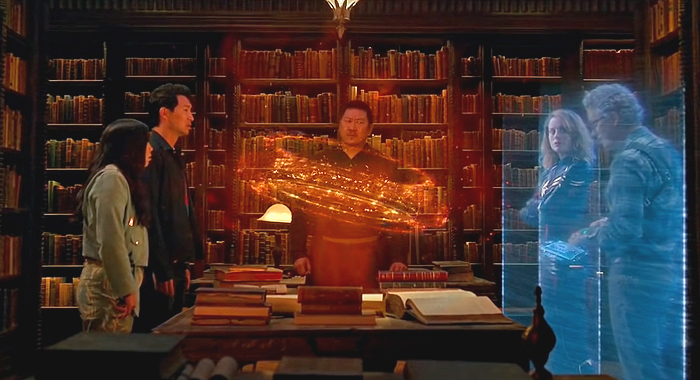
(Photo by ©Marvel Studios)
What is Nick Fury’s armada for?
Teased in the final moments of Phase 3, it is still unclear if Nick Fury has been building a space fleet in advance of Phase 5’s Secret Invasion or some other threat only he perceives.
Are all Mutants as long-lived as Namor?
The nature of Mutation is still a huge unknown in the MCU, but if so, it would allow certain Mutants with key ties to big 20th Century events to remain in those contexts. It would also make Wolverine a little less special… unless, of course, Marvel Studios is ready to introduce Externals (immortal Mutants) before the X-Men.
Will the governments of the Earth ever stop hassling Riri Williams?
Since the CIA knows she can build a vibranium detector, will they ever let her rest, or will the Ironheart series concern itself with how she finally escapes their attention?
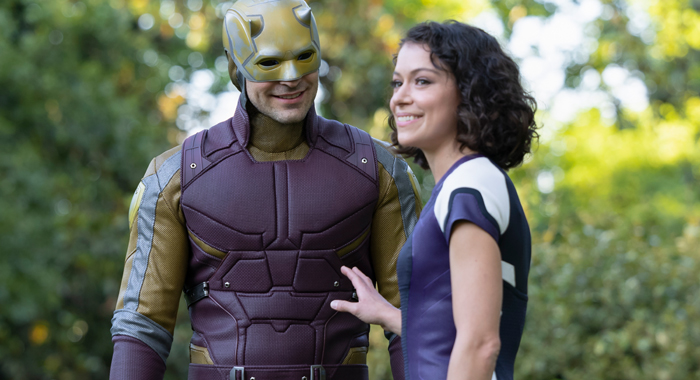
(Photo by ©Marvel Studios)
Was Matt Murdock blipped?
It’s fairly clear at this point that Fisk lost five years and his empire to Thanos’s calculus, but did it also happen to Matt?
Who is a Skrull?
Since the first Phase 5 TV show is Secret Invasion, fans should take another look at the Phase 4 projects for evidence of characters being replaced by Skrulls. Val, particularly in light of her actions in Wakanda Forever, feels like a prime candidate.
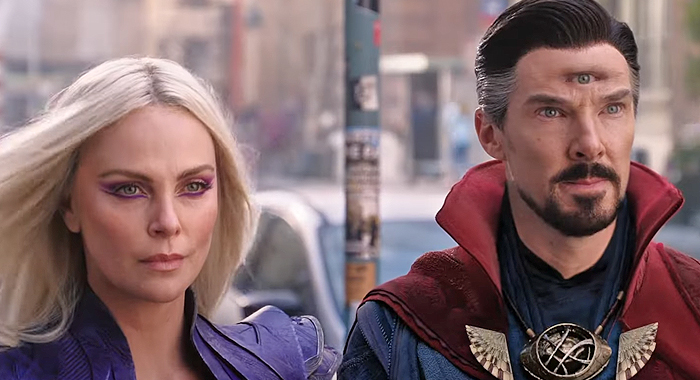
(Photo by ©Marvel Studios)
What incursion are Strange and Clea (Charlize Theron) off to face?
While Multiverse of Madness‘s end-credit scene suggests a plot for a third Doctor Strange, is it possible the incursion she warns him about occurs in another film? Potentially, another third film in an established Marvel series? Of course, Clea’s origins in the Dark Dimension may lead in a different direction.
What film will suddenly matter when we get to Avengers: Secret Wars?
Considering the way Avengers: Endgame recontextualized Thor: The Dark World, it is possible one of the Phase 4 films will take on a huge importance when we get to the final showdown with Kang.
How did you feel about Phase 4 of the Marvel Cinematic Universe? What would you like to see happen in Phase 5 and Phase 6? Let us know in the comments!